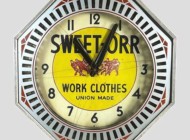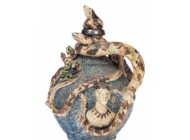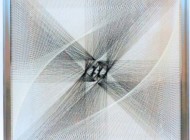
At the top of the sale was this summer Mandarin jacket and skirt from the late Nineteenth Century in remarkably preserved condition, which surpassed its $1,2/1,500 estimate to achieve $5,375.
Review by Z.G. Burnett
BELLOWS FALLS, V.T. — Finery came first on December 4, when Augusta Auctions presented its annual Vintage Wonderland auction, comprised of 250 lots of antique, vintage and couture garments, textiles and accessories. In addition to deaccessioned objects from the Valentine Museum, Richmond, Va., the estate of Lydia Gordon and Ohio State University, this auction featured new-to-market pieces from the estate of Baroness Aino Bodisco. More than just a title, Bodisco was an early patron of Oscar de la Renta and supported his career for decades. A midweek snowstorm in Vermont could do little to delay online bidding, and the auction yielded $137,500 in total.
Leading the sales was a late Nineteenth Century jacket and Mandarin skirt, made for summer weather from silk gauze. Both pieces showed cross and satin stitch embroidery, along with wool appliqué panels that depicted people from different social classes, plants, flowers and superbly executed dragonflies. The lot was described as being in very good to excellent condition, with only some discoloration and minor silk shattering. Buyers were undeterred, and the bids rose to $5,375.
Another top lot from central Asia also showed expert embroidery and demonstrated the many ways in which cultures can collide through fashion history. Dated to the mid Nineteenth Century was a ceremonial wool panel in fair to good condition, decorated with multicolored beads, metallic lace and lamé. Strung alongside these were cowrie shells, likely from the Indian Ocean, and late Eighteenth to early Nineteenth Century jeton coins minted by Lauer of Nuremberg — a generationally-owned German family business that specialized in minting tokens and coins. Those attached to the panel were arranged to form a sun, moon and star. The shells and coins were likely traded to the maker’s family, adding untold stories to this object’s history. It achieved $2,063.

This circa 1760 robe a la francaise ranked second in the auction and first of the top Eighteenth Century lots, achieving $4,250.
Earlier ensembles from the Eighteenth Century were popular with bidders. Second in the overall sales was a circa 1760 robe a la française in Lisere silk jacquard with meandering chevron and floral motifs throughout. This style is characterized by box pleats on the front and back of the skirt, known as robings, that revealed a decorated underskirt as one of the outfit’s many layers: in this case, a quilted example. These dresses required a large quantity of fabric to make, showing off both the fabric maker’s virtuosity and the wearer’s ability to purchase it. The robe was bid to $4,250.
In contrast to French maximalism, an Eighteenth Century robe a l’anglaise followed its continental cousin at $2,500. Unlike the funnel bodice of the francaise example, the English-style bodice showed a relatively more natural shape and its skirts gathered at the back in a more sacque-like shape. Both required panniers on either hip to fill out their skirts and displayed their underskirts. This example was made from pale pink silk moiré, patterned in a warp ribbon stripe of blue and ochre, underlaid by a silk taffeta petticoat embroidered with swag and scallop motifs.
Not content to let the ladies have all the fun, a four-piece gentleman’s suit made circa 1775-80 came in third at $3,750. The suit’s frock coat and breeches were cut from patterned velvet with original covered buttons and were lined in silk twill. The bespoke waistcoat showed satin stitch embroidery of climbing vines and roses, with a matching chain stitch border around the neck, pockets, buttonholes and hem. The fourth part of this lot was a leather-covered walking stick with a brass handle. Each piece showed wear and repairs appropriate to their age, but the suit was in very good condition overall.

This late Eighteenth Century men’s suit lot included a brass handled walking stick to complete the look and sold for $3,750.
Evening wear from the Twentieth Century was another favored category, especially that of the 1920s. A panné silk velvet dress and matching handbag by the Austrian American designer Sadie Nemser exceeded its $1,500 high estimate and achieved $2,625. Despite their fragile materials, both pieces retained many of their blue crystal seed beads, rhinestones, bronze lamé and silver thread embroidery, but had interior issues that demoted the outfit’s condition to fair or good.
From a year or so before, a six-piece Egyptian Revival costume worn by Edith Norman Hyde in 1919 came in at $2,063. Hyde wore this outfit during the first Miss America pageant, which she won despite the harem pants being almost too sheer for the time and occasion. The beauty contest portion of the pageant was itself a costume ball with a specifically “Oriental” theme. The lot included a scrapbook of the event and other related ephemera.
The latest garment in the upper lots was a Fall 1990 silk and quilted lamé gown from Geoffrey Beene. It was made from a silk jersey blend and belted by its black satin and silver lamé bodice panel. A few condition issues rendered the gown not quite red carpet ready, but it still multiplied its $800-$1,200 estimate to achieve $2,500.

This was one of two separate Nineteenth Century American-made broadcloth riding habits deaccesioned from the Valentine Museum, each of which rode to $2,000; this example was labeled “H. Silverman Ladies’ Tailor, NY.”
Two late Nineteenth Century American women’s riding habits and one traveling ensemble made up a small murder of black outfits in three separate lots. First among them was a habit from Faust, Washington, DC, circa 1890, in two pieces and in very good condition. Its red faux waistcoat and gold buttons stood out against the black broadcloth, and the lot sold for $2,000. The second habit from “H. Silverman Ladies’ Tailor, NY,” per the label, was made a decade earlier, included a gray broadcloth jacket and skirt lined with silk twill and retained its original wool knit-base broadcloth breeches. It was also bid to $2,000. Last in the trio was a three-piece black broadcloth traveling ensemble in very good condition that achieved $1,813.
The definition of “casual” has changed significantly with regard to clothing in the past 100 or so years, as demonstrated by two lots from 1905. The first of these was an embroidered silk pongee day dress in excellent condition, boasting distinctive chemical lace medallion appliques to the band collar and front, a Heilmann embroidered yoke, fitted lower sleeves and a daring art nouveau gold-tone buckle on its integrated belt. The dress sold for $1,875. An embroidered silk tulle, crepe chiffon and taffeta tea gown designed by Abraham and Straus, Brooklyn, Paris, featured a “monobosom” bodice, which is the rough equivalent of today’s tank top, followed; it was bid to $1,563.
Prices quoted with buyer’s premium, as stated by the auction house. Augusta Auctions’ Vintage for Valentines online sale will be conducted on February 12. For more information, www.augusta-auction.com or 802-463-3333.




















